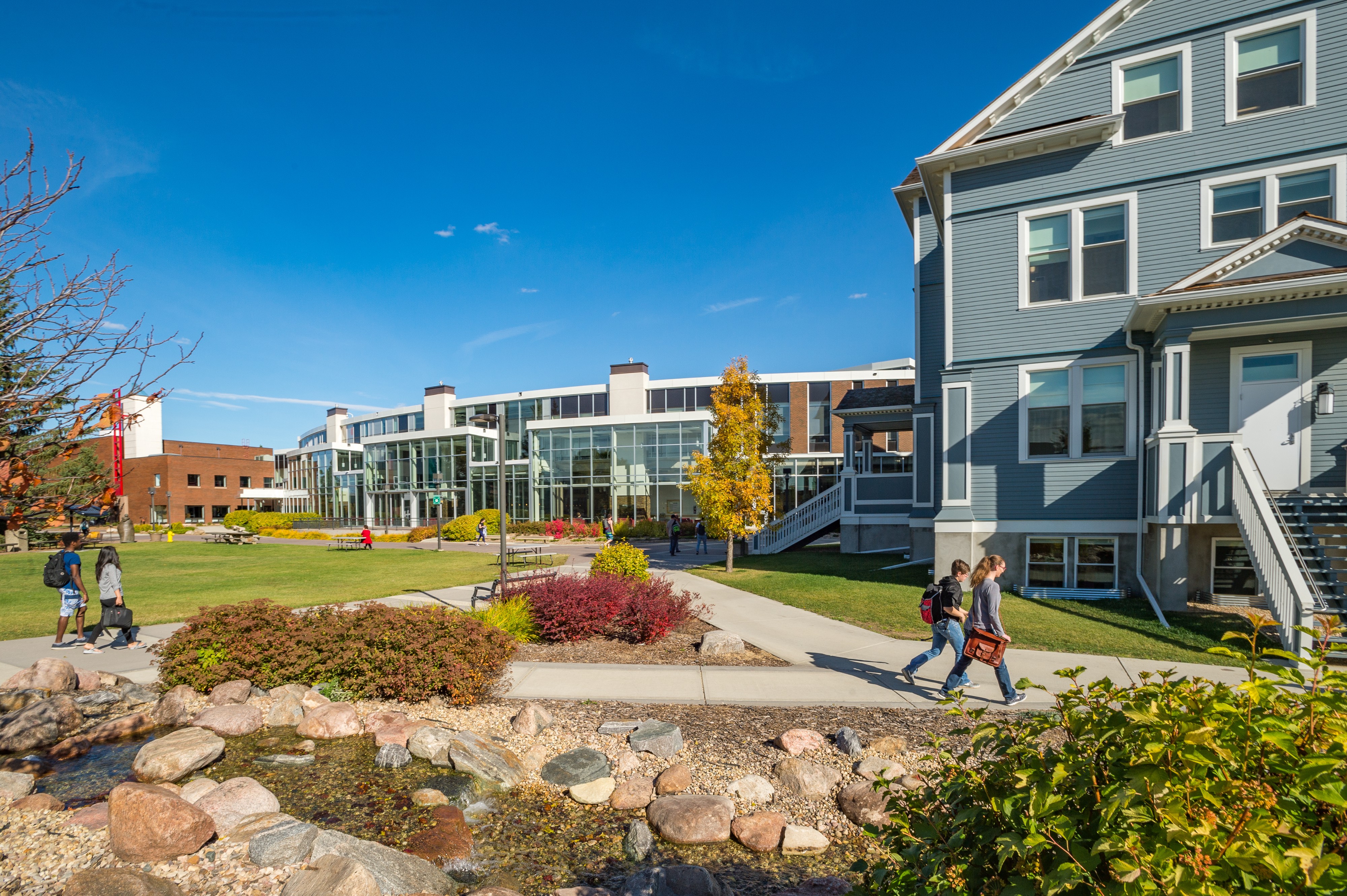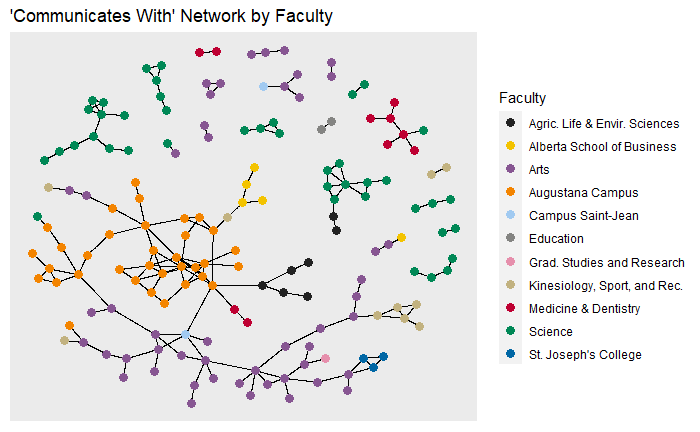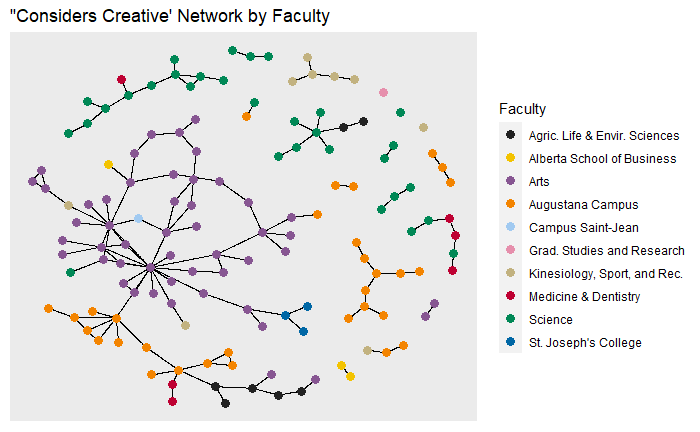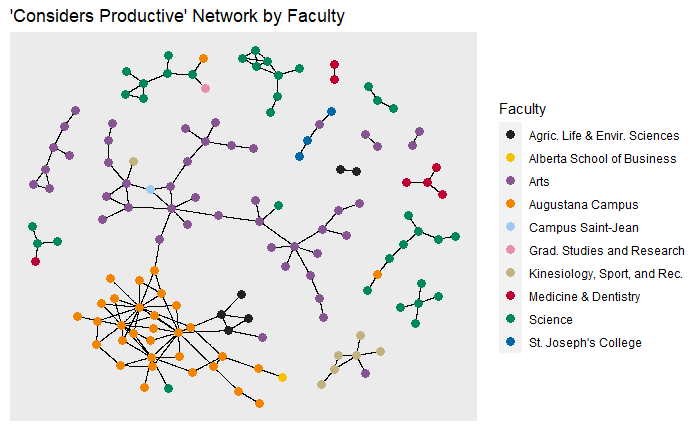
During a pandemic, our social networks are vital for connecting with friends and family, especially as our face-to-face networks have been disrupted to limit the spread of the contagion. Similarly, our academic social networks are crucial for the maintenance of our links to existing and potential research collaborators and for the diffusion of ideas that may stimulate the directions of our own research.
This piece considers some results of a research project to assess the place of Augustana Campus within the University of Alberta's academic social network. This project began as an idea in a directed study course based on Matthew O. Jackson's Social and Economic Networks (Princeton University Press, 2008) and grew into an ethics-approved survey in November 2017 of Augustana academics and others in UAlberta departments deemed to focus on subjects similar to those taught at Augustana. We sent the survey to more than 1400 academics, at all levels from instructor to full professor; 191 completed surveys were received, comprising 35 from Augustana, 57 from the Faculty of Arts, 52 from the Faculty of Science, and some from eight other faculties. We regarded Campus Saint-Jean (CSJ), Native Studies, and St. Joseph's College (SJC) as important comparison groups for Augustana but did not receive enough surveys from them (only 3 from each of CSJ and SJC) for statistical significance.
To examine their academic social network, we asked participants to choose (from a drop-down list of all those surveyed) the five UAlberta academics with whom they communicate most. The results surprised us. For geographical reasons, we had expected academics at Augustana Campus to be quite isolated, socially, from those in faculties at the North Campus. However, the homophily (in this case, the tendency of those in one faculty to choose others from the same faculty) was slightly but significantly lower for Augustana (85.7%) than it was for the Faculty of Arts (90.2%) and the Faculty of Science (91.5%). Homophily was even lower for Campus Saint-Jean (66.7%) and St. Joseph's College (40%); this might suggest that academics at CSJ and SJC are less isolated from other faculties than are those in much larger faculties (e.g. Arts, Science) as well as those at Augustana. However, as noted above, the number of surveys received from folks at CSJ and SJC renders their homophily scores statistically unreliable.
 Figure 1
Figure 1
Figure 1 displays an image of the network generated by our communicates-with data. Every node in this network represents one survey participant, and every edge linking two nodes indicates that one of these nodes has named the other as one they communicate with. Hence these edges have a direction, sometimes shown by an arrow, creating a directed network (better known to mathematicians as a directed graph); an edge is bidirectional if the linked nodes communicate with each other. Note that Figure 1 shows only the edges (and the nodes they link) that represent communication from one survey participant to another participant; even though 552 non-participants were named as communicatees, we decided for ethical reasons not to display their information.
Exactly 164 (of 191) survey participants are shown in Figure 1. The most striking feature of this network, from our perspective, is the giant component (or bubble, to use a popular term in these COVID times) containing 91 nodes from ten different faculties. This bubble is a potential engine for interfaculty research. Augustana's place within it is truly remarkable; in fact, some Augustana nodes are central to it. Note, for example, that one Augustana node is linked to nodes in three other faculties. Nodes like this are an example of betweenness, which can confer considerable influence within a network. The Medici family rose to preeminence in 15th century Florence in part because of this kind of centrality within the network of Florentine marriages (Jackson, pp. 4-6): marital paths linking the powerful families of Florence tended to pass through the Medici family, even though the Medicis began with less wealth and political clout.
With respect to the wielding of power, Augustana and its faculty members are nothing like the Medicis. For the most part, Augustana folks are quiet, modest, and unassuming. Nevertheless, our little research project can, we believe, inform the work of the Academic Restructuring Working Group (ARWG). Augustana sees its focus as the liberal arts and sciences. Therefore, we were excited to see that the Consolidation Model and Hybrid Model in the ARWG's Revised Proposals include a new Faculty of Arts & Science. Figure 1 indicates that the Faculty of Arts and the Faculty of Science are weakly linked. A new Faculty of Arts & Science would almost certainly strengthen the connections between academics in these now separate faculties. It is also clear from the giant component in Figure 1 that Augustana is closely linked to the current Faculty of Arts (based on the survey data from November 2017), much less so with the Faculty of Science, which has only one node in the giant component. We are pleased that, from our perspective, all three models in the ARWG's Revised Proposals give Augustana the autonomy to cultivate relationships with its communities (Camrose, rural Alberta) and with groups inside the U of A. A close association of some kind between Augustana and a new Faculty of Arts & Science would reinforce Augustana's links to the existing Faculty of Arts and, we hope, help build connections with those in the current Faculty of Science.
In sum, our research, especially Figure 1, offers an argument in favour of a new Faculty of Arts & Science. This new faculty, we think, would help dismantle the silos that societies and universities have built around two powerhouses of liberal inquiry. Mathematics, for example, is both an art and a science, and we suspect other disciplines view themselves similarly. In any case, it is clear that universities are moving towards more interdisciplinarity, aided by the wider reach of new technologies. A new Faculty of Arts & Science, we believe, would inevitably promote interdisciplinary research and foster the growth of a culture that would aid Augustana, and vice versa.
 Figure 2
Figure 2
Finally, for the reader's interest, we offer two more perspectives on Augustana's place in the UAlberta network: Figure 2 shows the network generated by asking survey participants to choose the three UAlberta academics they consider to be the most creative; Figure 3 is the same, except participants chose the three they judged to be the most productive.
 Figure 3
Figure 3
Cameron RaynorCameron Raynor attended Augustana where he majored in economics and mathematics and was part of the inaugural cohort of the Lougheed Leadership College. In 2018, he co-founded campaign technology and data company RA2 that specializes in providing digital campaign and stakeholder engagement services. RA2 is currently part of the Platform Calgary Junction program for Calgary-based technology-driven businesses.

William HackbornWilliam Hackborn (who prefers to be addressed simply as "Bill") is a Professor of Mathematics and Computing Science at Augustana Campus. He has dabbled in various mathematical areas over the years, including fluid dynamics, dynamical systems, mathematical biology, and most recently the history of mathematics and physics. Bill anticipates, with mixed emotions, his upcoming retirement on 30 June 2021.